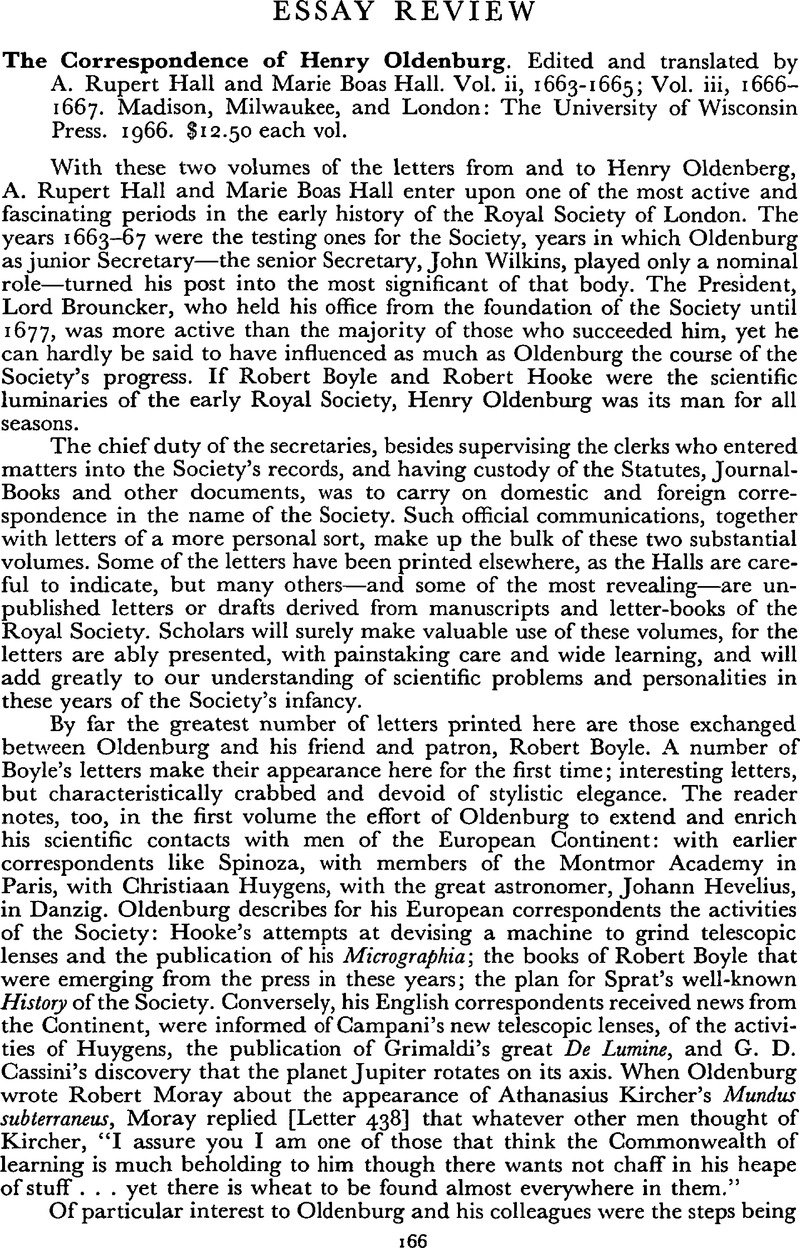No CrossRef data available.
Article contents
Abstract

- Type
- Essay Review
- Information
- Copyright
- Copyright © British Society for the History of Science 1968
References
1 Cambridge University Library, MS. Add. 3975. See Hall, A. R.: “Sir Isaac Newton's Notebook, 1661–65”, Cambridge Historical Journal, ix (1948), 239–250CrossRefGoogle Scholar. For the entries “Out of Streete”, see fols. 27v–30v.
2 Correspondence of Isaac Newton, ed. Turnbull, H. W., vol. i (1949), p. 11.Google Scholar
3 The comet was first observed, though not in England, on 17 November 1664; it reached perihelion on 4 December. See Holetschek, J.: “Untersuchungen über die Grösse und Helligkeit der Kometen, I. Die Kometen bis zum Jahre 1760”, Akademie der Wissenschaften, Wien; Mathematisch-naturwissenschaftliche Klasse. Denkschriften, lxiii (1896), 462.Google Scholar
4 As the Halls explain [vol. ii, p. 429, note 4], Wren was relieved of this assignment early in 1665 and “commissioned by Charles II to prepare a scheme for rebuilding St. Paul's Cathedral (not yet destroyed by the Fire)”. Hooke's colleagues were annoyed by his dilatoriness. See letters Nos. 418 and 454 of Moray to Oldenburg. Though Hooke presented his results to the Royal Society on 8 August 1666, they were not published until 1678.
5 Phil. Trans. No. 1 (6 03 1664–1665), pp. 3–8Google Scholar; No. 2 (3 April 1665), pp. 17–20; No. 3 (8 May 1665), pp. 36–40; and No. 6 (6 November 1665), pp. 104–108.
6 Aware that conjectures about cometary paths “be now stirring”, Wallis in this important letter describes the cometary hypothesis found among the papers of Jeremiah Horrox. Horrox imagined that comets originate in the sun and return to it in a curved path “by an Ellipticall figure or near it”. Letter No. 366, Wallis, to Oldenburg, , 21 01 1664–1665Google Scholar. To be sure, Thomas Hariot, long before, had proposed elliptical cometary paths about the sun.
7 Petit's book has been unduly neglected. White, Andrew D. called it a “vehement attack on superstition, addressed to the young Louis XIV” (History of the Warfare of Science with Theology, New York, 1897, vol. i, p. 198Google Scholar). G. Atkinson in a valuable paper treats Petit as a precursor of Bayle and Fontenelle, and has gathered useful information on the comet of 1664. See his “Précurseurs de Bayle et de Fontenelle”, Revue de littérature comparée, xxv (1951) 12–42.Google Scholar
8 The Diary of Samuel Pepys, ed. Wheatley, Henry B., vol. iv, p. 341Google Scholar. Hooke's lecture (Pepys describes it as his second one on the comet) was an afternoon public lecture given in his capacity as Professor at Gresham College.
9 Phil. Trans., No. 1 (6 03 1665), p. 6.Google Scholar
10 Phil. Trans., No. 6 (6 11 1664–1665), p. 105.Google Scholar
11 See Atkinson, , loc. cit., pp. 27–28Google Scholar. The meeting was described at some length in the Journal des Sçavans.
12 Letter 589 and Phil. Trans., No. 21 (21 01 1666–1667), pp. 373–376.Google Scholar
13 They follow immediately after a reference (MS. Add. 3975, fol. 20v) to Auzout's estimates of the apparent diameters of certain stars. Auzout's name is barely decipherable, but the figures Newton ascribes to him are those that appear in an abstract of a paper of Auzout published in Phil. Trans., No. 4 (5 06 1665), pp. 57–63.Google Scholar
14 See, for example, Principia (1687), p. 4Google Scholar (Bk. III, Prop. XXXIX, Lemma IV, Corol. 3) where Newton emphasizes the retrograde motion of some comets: “Hinc etiam manifestum est, quod coeli resistentia destituuntur. Nam Cometae vias obliquas & nonnunquam cursui Planetarum contrarias secuti, moventur omnifariam liberrime, & motus sous etiam contra cursum Planetarum diutissime conservant”. In later editions of the Principia the section on comets is greatly expanded and Newton not only invokes Halley's results, but devotes considerable space to the observations on the comet of 1664 made by Hevelius, Auzout, Pierre Petit, and Hooke, all of whom are named.
15 Birch, T., History of the Royal Society of London, vol. ii, pp. 69–72Google Scholar. Hooke sought to determine whether the force of gravity varies with the distances from the centre of the earth.
16 Ibid., p. 92.


